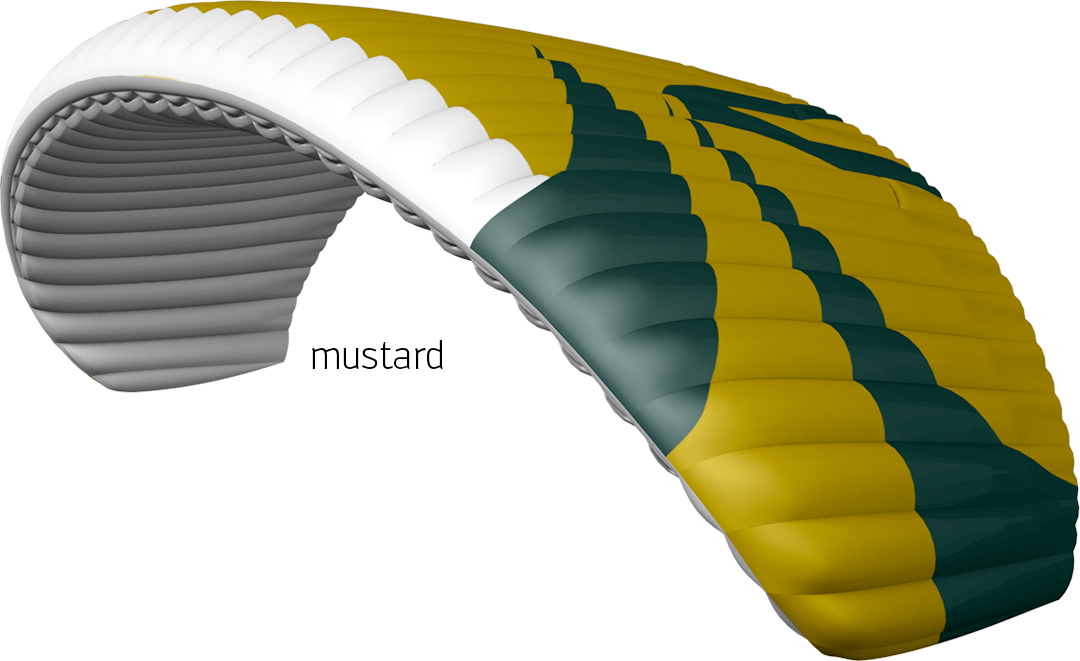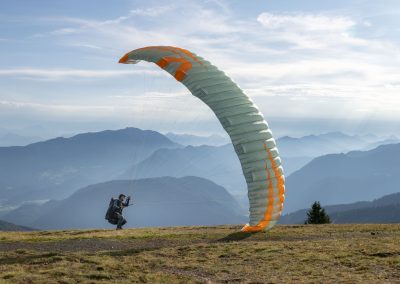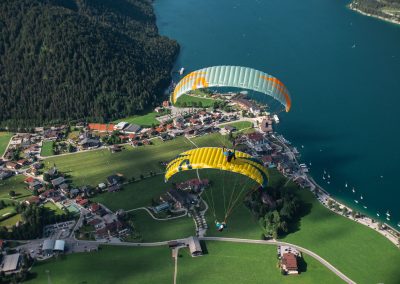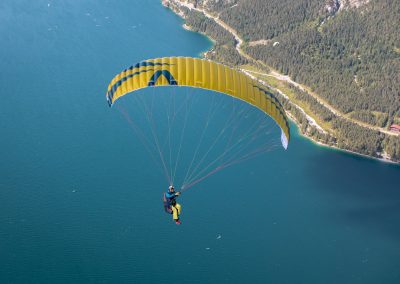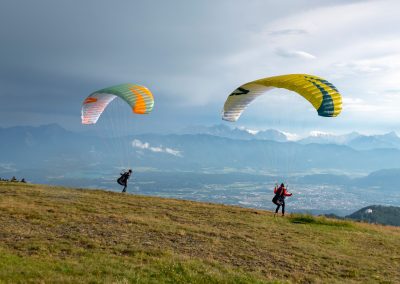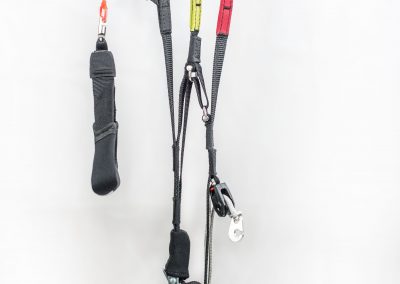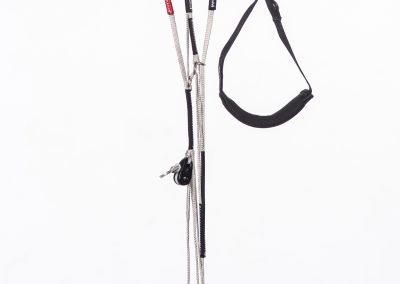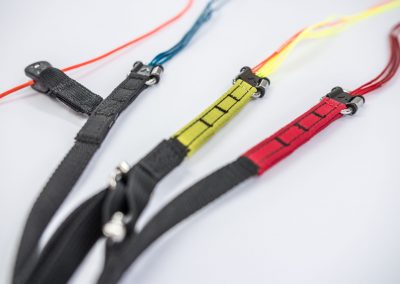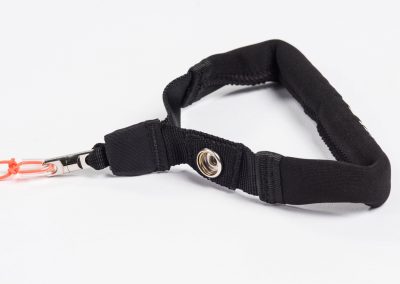The fun machine.
Energetic. Direct.
The TONIC2 is the fun machine in our mini-wing range. The super-compact wing with short span and short lines is aimed at those who like to soar in strong winds or close to the slope. We like to call the TONIC2 the “go-kart” of the air because it converts control impulses directly and precisely and loves high banking and dynamic turns. Nevertheless, the field of application is surprisingly versatile – depending on the size you choose.
The TONIC2 is not only a perfect strong-wind glider, but also an ideal practice glider for ground-handling, wingover and looping training and a perfect companion for hike&fly tours. It has enough performance to glide out of every valley or even stay up on thermal days.
A carefully selected mix of materials ensures the necessary robustness in dunes as well as low weight for hike&fly. A special feature is the trimmer riser with which the speed window can be significantly increased. One thing is common to all sizes: The TONIC2 is extremely easy to handle, extremely fun in the air and extremely tough!
“The fun machine for everyone. For dune flying or freestyle – I always take my TONIC with me on vacation!”
Flight chracteristics
The TONIC2 can be laid out in the smallest area due to its small span and short lines. Launch preparations are incomparably easy. A tug on the lines and the canopy rises up compactly and evenly. Because the TONIC2 develops lift fast, the pilot takes off quickly – this was an important point in the specifications when developing our new mini-wing.
The TONIC2 immediately converts control inputs and weight shifting into high banks and steep curves. The reactions are moderate and manageable, but if you have no experience with mini-wings, you should approach this feature slowly.
The reactions vary depending on the size and the corresponding surface loading. With a low load, the TONIC2 is suitable for thermal flying, but if it is heavily loaded it becomes a strong-wind rocket on cliffs and dunes.
In turbulence, the TONIC2 remains stable, but requires an active flying style due to its agility – especially at high wing loading. The brake line pressure increases sharply right up to the stall, and you can adjust your speed precisely for landing with the brakes.
The application range of the TONIC2 is extremely versatile, depending on the size you choose. The reactions vary depending on the glider size and the corresponding wing loading. With low wing loading the TONIC2 is suitable for thermal flying, while with high wing loading it becomes a real miniwing. The graphic will help you choose the right size!

JET FLAPS
Our JET FLAPS extend the green arc as you approach the stall point, which substantially increases safety and also improves climb performance.

RIGID FOIL
The Rigid Foil nylon wires on the leading edge help maintain its shape and ensure constant ram air pressure. Advantages: better takeoff behavior, more performance and lower canopy weight.

3D-SHAPING
A precise calculation of the leading edge geometry and the installation of an additional strip of fabric reduce wrinkling in this sensitive part of the glider. Advantages: exact wing shape, more performance.

LOOPS & HOOKS
Two sewn-in loops on the top surface in the leading edge area enable straps to be attached with a few pins, in order to to lay out the canopy in difficult alpine terrain.

MINI RIBS
Doubling the number of cells at the trailing edge increases its shape stability substantially. Advantage: fewer vortices improve the aerodynamics and with it the performance.

SHARK NOSE
Together with a corresponding wing design, the shark nose technology improves pressure distribution in the canopy substantially. Advantages: much more solid flying feeling and substantial performance gain, especially when gliding on bar.
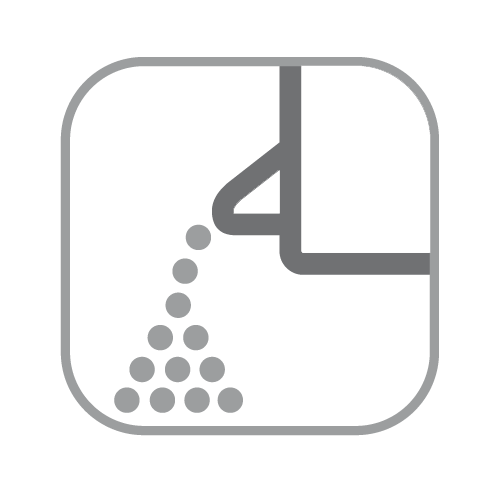
AUTOMATIC SAND RELEASE SYSTEM
Porous openings of the profile ribs at the trailing edge ensure that sand and dirt in the glider are automatically guided to the wingtip where they can trickle out. This helps preserve the material and “relieves” the trailing edge.
| Size | XS | S | M |
| Cells | 33 | 33 | 33 |
| Area flat (m²) | 16,3 | 18,7 | 21,1 |
| Area projected (m²) | 14,00 | 16,00 | 18,10 |
| Wingspan flat (m) | 8,4 | 9,0 | 9,6 |
| Wingspan projected (m) | 6,75 | 7,24 | 7,69 |
| Aspect ratio flat | 4,33 | 4,33 | 4,33 |
| Aspect ratio projected | 3,27 | 3,27 | 3,27 |
| min. profile depth (cm) | 95 | 102 | 109 |
| max. profile depth (cm) | 237 | 254 | 269 |
| Glider weight (kg) *with Dyneema-Riser. Weight with Regular-Riser +200g | 2,4 | 2,6 | 2,8 |
| Certified weight range (kg) EN/LTF B | / | 50 - 85 | 65 - 105 |
| Certified weight range (kg) EN/LTF C | 50 - 95 | 86 - 105 | 106 - 120 |
| Upper sail | Porcher Skytex 38g / Dominico Dokdo 32g |
| Lower sail | Porcher Skytex 27g |
| Ribs | Skytex 27 hard |
| Bands | Skytex 27 hard |
| Main lines | Liros PPSLS 180 |
| Middle lines | Liros PPSLS 125/65 |
| Top lines | Liros DC60 |
| Brake lines | Liros DFLP 200/32, Liros PPSLS 65 |
| Regular-Risers | Güth & Wolf 12mm Gurtband |
| Dyneema-Risers | Liros 6mm Dyneema |
- TONIC2 XS LTF/EN Flight test report
- TONIC2 S LTF/EN Flight test report
- TONIC2 M LTF/EN Flight test report
- TONIC2+ S LTF/EN Flight test report
- TONIC2+ M LTF/EN Flight test report
What does TONIC2+ mean?
What are "Loops&Hooks" and how do I use them?
In difficult terrain, you can attach ribbons to the loops, which are then weighted with an object (stone, branch, etc.). This keeps the leading edge open prevents the wing from sliding away in steep terrain.
What does TONIC2+ mean?
The TONIC2 was tested in sizes S and M in two different weight ranges. However, these weight ranges were not tested according to the same classification and the test center cannot use the same name for two classifications. For this reason, the second, higher classified weight range in the flight test report is called “TONIC2 +”. This name can only be found on the flight test report and has more of a bureaucratic than a technical background.
Which size should I choose this glider?
The application range of the TONIC2 is extremely versatile, depending on the size you choose. The reactions vary depending on the glider size and the corresponding wing loading. With low wing loading the TONIC2 is suitable for thermal flying, while with high wing loading it becomes a real miniwing. The graphic will help you choose the right size!

Is the deterioration on light-cloths higher than on a regular glider cloth?
Light-cloths are thinner than conventional glider-cloths and therefore less resistant against mechanical strain. That means you need to pay more attention on small rocks and bushes. Please avoid any unnecessary contact to the ground. With this strict observance you will have the same durability as with a conventional glider-cloth.
What are the glide ratio (L/D), trim and maximum speeds?
We know that these data are interesting for you as a pilot, but for us to publish them would be a bad idea for the following reasons:
1) Performance data are highly dependent on the drag of the pilot and are thefore related to sitting position and harness. The difference between aerodynamically favorable and unfavorable harnesses and sitting positions can be as much as a whole L/D number.
2) Performance increases with the size of the glider. A large glider will always outperform the same glider in a smaller size. So a question about the performance of a glider is always also a question about the size.
3) There is no normed method of testing the performance of paragliders. For example, speed varies with altitude and the associated different air pressure, but also with the total weight of the system.
That means that there simply isn’t THE speed or THE L/D that would allow a serious comparison with another glider. Performance data are dependent on the harness, the size of the glider, on the air mass and the total weight.
How do I calculate my takeoff weight?
Takeoff weight is calculated by adding the weight of the pilot including clothes to the weight of the equipment. The equipment consists of the harness, the reserve chute, the paraglider itself, and any flight instruments and other baggage you may carry (e.g. rucksack, etc.).
Is it OK for me to shorten the brake lines on my skywalk paraglider?
Changing the length of the brake lines can have a negative effect on the flying characteristics and extreme flight behavior. The paraglider needs a little more lead when flying on speed bar, otherwise the glider could be braked unintentionally, leading to a loss of performance. When performing extreme flying maneuvers, shortening the brake lines too much can cause complications during recovery from collapses, parachutal stall, etc.
Am I allowed to make modifciations to my skywalk paraglider?
No, because the glider is certified the way it is delivered to you. Even the brake line length is part of the trim and must not be changed.
Why shall I not navigate my glider through the C-level?
As opposed to gliders with two line levels with which you can change the angle of attack by pulling the rear risers, doing the same on a glider with three line levels causes the profile to deform. This results in a crease forming between levels, which makes the glider more susceptible to collapses. In an emergency, control deflections of several centimeters are possible.
Do the nylon wires in the glider need any special attention or packing method?
Our nylon wires are flexible and kink resistant, so they won’t break under normal circumstances. But due to the packing volume it is a good idea to lay the Rigid Foils in the leading on top of each other on both sides.
What are JetFlaps and how do they work?
Jet Flaps are a so-called split flap like those seen on a large airplane. When the glider is braked, the airflow is routed through the glider, restoring smooth airflow. This extends brake line travel and softens the stall behavior.
What advantage do the JetFlaps on my skywalk paraglider offer?
Lower flyable minimum airspeed. The speed range is wider and easier to control. The pilot has more time to react when flying near the stall point.
Your TONIC package
-
- 1x Compression strap
- 1x Innerbag for glider
- 1x Riser bag
- 1x pair Hooks
- 1x BASIC GUIDE
- 1x Bandana
- 1x Self-adhesive repair patch


